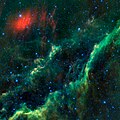ملف:Menkhib and the California Nebula.jpg
المظهر

حجم هذه المعاينة: 600 × 600 بكسل. الأبعاد الأخرى: 240 × 240 بكسل | 480 × 480 بكسل | 768 × 768 بكسل | 1٬024 × 1٬024 بكسل | 2٬048 × 2٬048 بكسل | 4٬095 × 4٬095 بكسل.
الملف الأصلي (4٬095 × 4٬095 بكسل حجم الملف: 1٫88 ميجابايت، نوع MIME: image/jpeg)
تاريخ الملف
اضغط على زمن/تاريخ لرؤية الملف كما بدا في هذا الزمن.
| زمن/تاريخ | صورة مصغرة | الأبعاد | مستخدم | تعليق | |
|---|---|---|---|---|---|
| حالي | 13:30، 12 مايو 2010 |  | 4٬095 × 4٬095 (1٫88 ميجابايت) | Originalwana | {{Information |Description={{en|1=This infra-red image from NASA’s WISE (Wide-field Infrared Survey Explorer) features one of the bright stars in the constellation Perseus, named Menkhib (th |
استخدام الملف
الصفحة التالية تستخدم هذا الملف:
الاستخدام العالمي للملف
الويكيات الأخرى التالية تستخدم هذا الملف:
- الاستخدام في en.wikipedia.org
- الاستخدام في fa.wikipedia.org
- الاستخدام في fr.wikipedia.org
- الاستخدام في gl.wikipedia.org
- الاستخدام في lb.wikipedia.org
- الاستخدام في mk.wikipedia.org
- الاستخدام في my.wikipedia.org
- الاستخدام في pl.wikipedia.org
- الاستخدام في pt.wikipedia.org
- الاستخدام في ro.wikipedia.org
- الاستخدام في ta.wikisource.org


